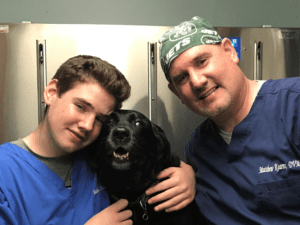By Matthew Kearns, DVM
 Essential oils are all the new craze in both human and veterinary alternative therapies. Are they safe? Do they work?
Essential oils are all the new craze in both human and veterinary alternative therapies. Are they safe? Do they work?
I would like to write a little disclaimer at this time: I do not work for or promote any essential oil products in my clinic. I am just aiming to put forth information in as neutral a position as I can.
Essential oils are produced naturally by plants, and the term essential oil describes the plant’s “essence” or fragrance. They can be used to promote healing, decrease inflammation and pain, etc. Some essential oils are applied directly to the affected area (usually the skin), ingested (this gets a little bit scary because the essential oil industry is not regulated by the FDA for quality or purity) or inhaled (via a diffuser).
The potential of using essential oils topically is very interesting. I have spoken previously about the risk of antimicrobial (bacteria and fungi) resistance in veterinary medicine. This, as in human medicine, is an unwanted sequelae of the overuse of antibiotics and antifungals in chronic, recurrent infections. Usually there is some underlying primary problem (allergic skin or ear infections, urinary incontinence, etc.) and a secondary infection. Initial studies show promise in their antimicrobial activity, but also show damage to the skin and lining of the ear itself. Basically, research is ongoing.

Using essential oils orally is also being evaluated. The three main essential oils are: ginger, turmeric and cannabidiol (the non-THC portion of the plant). I authored an entire article on the use of medical marijuana a little over a year ago discussing both marijuana and hemp so I will focus on turmeric and ginger for this article.
Turmeric’s main property is antineoplastic (anticancer) and anti-inflammatory effects. Turmeric not only has direct antineoplastic benefits, but there is also evidence that it has a synergistic effect when used with chemotherapy. Ginger’s main effect is to reduce gastrointestinal spasming and inflammation. It is particularly effective as an antinausea agent. The biggest problem with both turmeric and ginger is absorption. Absorption for both of these essential oils is very variable.
Lastly are aerosolized essential oils, or aromatherapy. These essential oils are mainly used for mood stabilization or behavioral issues. This form is the most controversial as in-depth studies have not been performed in veterinary medicine. I don’t want to say they don’t work, but it is more something that has to be evaluated on a case-by-case basis. Use caution if you have birds in your house. Many of the aerosolized essential oils can cause serious, life-threatening, respiratory inflammation in avians.
In conclusion, my opinion is that there is great potential for the use of essential oils in veterinary medicine but use caution at this time. As more information is published in the literature, I will update everyone.
Dr. Kearns practices veterinary medicine from his Port Jefferson office and is pictured with his son Matthew and his dog Jasmine.




 I recently had a pet owner come in and ask me if grain-free diets were dangerous. I knew there were risks of bacterial and parasitic contamination in raw diets but had not heard anything about grain-free diets. Time to investigate.
I recently had a pet owner come in and ask me if grain-free diets were dangerous. I knew there were risks of bacterial and parasitic contamination in raw diets but had not heard anything about grain-free diets. Time to investigate. 
 The ear canal contains epithelial cells (those similar to skin), ceruminous cells and apocrine cells (cells that produce earwax). Epithelial cells will turn over, or be replaced every few days and, along with a small amount of earwax, migrate toward the entrance of the canal. Once at the entrance a good shake of the head sends it out to the world. If the lining of the ear canal becomes inflamed, it narrows due to swelling (most likely due to some sort of food or environmental/seasonal allergy) and excessive ear wax is produced. This combination not only overwhelms the ear’s ability to clear the wax, it also leads to a warm, dark and moist environment and allows the normal bacteria and yeast to go crazy.
The ear canal contains epithelial cells (those similar to skin), ceruminous cells and apocrine cells (cells that produce earwax). Epithelial cells will turn over, or be replaced every few days and, along with a small amount of earwax, migrate toward the entrance of the canal. Once at the entrance a good shake of the head sends it out to the world. If the lining of the ear canal becomes inflamed, it narrows due to swelling (most likely due to some sort of food or environmental/seasonal allergy) and excessive ear wax is produced. This combination not only overwhelms the ear’s ability to clear the wax, it also leads to a warm, dark and moist environment and allows the normal bacteria and yeast to go crazy.




 My last column introduced the seasonal allergies that our pets can suffer from, also known as atopic dermatitis. This second part of the two-part article focuses more on the treatment of atopic dermatitis. The treatments we will discuss only focus on systemic medications. It does not include supplements, topical creams/powders/sprays, medicated shampoos/conditioners, etc. I’ll make sure to cover that in the future.
My last column introduced the seasonal allergies that our pets can suffer from, also known as atopic dermatitis. This second part of the two-part article focuses more on the treatment of atopic dermatitis. The treatments we will discuss only focus on systemic medications. It does not include supplements, topical creams/powders/sprays, medicated shampoos/conditioners, etc. I’ll make sure to cover that in the future. Corticosteroids, glucocorticoids, or “steroids,” as they are sometimes referred to, are all cortisone derivatives. Systemic cortisone medications are prescription only. However, corticosteroids are inexpensive and very effective at treating atopic diseases. They block the production of all cytokines (mediators of inflammation) and, if it wasn’t for the side effects, would be a magic bullet. Short-term use is relatively safe and very beneficial. Side effects include drinking/urinating more, eating more and panting.
Corticosteroids, glucocorticoids, or “steroids,” as they are sometimes referred to, are all cortisone derivatives. Systemic cortisone medications are prescription only. However, corticosteroids are inexpensive and very effective at treating atopic diseases. They block the production of all cytokines (mediators of inflammation) and, if it wasn’t for the side effects, would be a magic bullet. Short-term use is relatively safe and very beneficial. Side effects include drinking/urinating more, eating more and panting.




